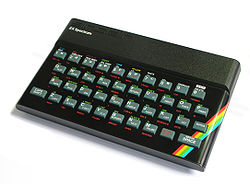The ZX Spectrum is 30 years old. Sinclair ZX Spectrum 30th Anniversary is today. Happy birthday Spec. ZX Spectrum, the microcomputer launched in 1982 by Sinclair Research (Cambridge, UK) is seen by many today as the inspiration for a generation of eager young programmers, software and game designers in the UK. It has inspired many people also outside UK, including me. My first computer was Sinclair ZX spectrum. The successor to Sir Clive Sinclair’s ZX81 – at the time the world’s best selling consumer computer – it introduced colour “high resolution” graphics and sound. The design was sleeker than anything else on the market and price was good too. That allowed adverts at the time to boast: “Less than half the price of its nearest competitor- and more powerful”. ZX Spectrum’s chief designers reunited 30 years on article gives some background how this computer was created. Read also Happy 30th Birthday, Sinclair ZX Spectrum – The story of an historic micro.
I remember starting my ZX Spectrum computing 1983 by first playing Jetpac game that was cool game at the time (check Jet Pack remake for web browser if you want to try). I remember playing that game so much that quite shortly I broke down the keyboard because of too much playing. After some time I started programming, first with built-in Basic. Later also Assembler (the manual had the assembler commands and their coded listed on the end which was cool) and some other languages. Then I did also some hardware hacking, including installing a better keyboard and adding my own joystick interface to it (my own design compatible with Interface 2 joysticks). It 80′s was fun hacking time.

116 Comments
Tomi Engdahl says:
https://hackaday.com/2023/09/12/zx-spectrum-gets-a-3d-fps-engine/
Tomi Engdahl says:
https://virtualconsoles.com/online-emulators/zx-spectrum/
Tomi Engdahl says:
https://hackaday.com/2024/01/26/a-zx-spectrum-raytracer-in-basic/
Tomi Engdahl says:
ZX Spectrum PCB Schematics and Layout
Here you’ll find schematic and layout information for various models of the ZX Spectrum.
https://spectrumforeveryone.com/technical/zx-spectrum-pcb-schematics-layout/
Tomi Engdahl says:
https://www.specnext.com/about/?fbclid=IwAR2Ohr7vWXqlZupQ4OVmpSNx72Zh5nWg-EOwFhfHCAad-epTx_1Q6sWjFVk
Tomi Engdahl says:
https://github.com/jacobly0/llvm-project
Tomi Engdahl says:
The Z80′s secret feature discovered after 40 years!
https://www.youtube.com/watch?v=DLSUAVPKeYk
Tomi Engdahl says:
https://hackaday.com/2024/03/11/playing-zx-spectrums-manic-miner-on-the-arduino-uno/
Although it seems many have moved on to 32-bit MCUs these days for projects, there is still a lot of fun to be had in the 8-bit AVR world, as [Scott Porter] demonstrates with a recent Arduino Uno project featuring his game engine running a port of the Manic Miner game that was originally released in 1983 for the ZX Spectrum. For the video and audio output he created an add-on board for the Uno that creates a composite signal using two resistors, along with an audio driver circuit and control inputs either from the onboard buttons or from a NES controller. Audio can be sent either over the composite output or via the audio jack.
Tomi Engdahl says:
Elite: “The game that couldn’t be written”
https://www.youtube.com/watch?v=lC4YLMLar5I
Elite may be the most complex 8-bit game ever produced. And it was arguably the most groundbreaking game ever released for its time. Back in the early 1980s when arcade-shooters reigned supreme, two undergraduates at Cambridge redefined what computer games even were.
In this video we’ll look at some of the technical aspects of how David Braben and Ian Bell were able to construct an entire universe, economy, 3D engine and backstory in 22KB on a 2MHZ processor. This story is well known in the UK, but computer games history is largely told through the lens of the US and Japan….so overseas viewers may not be familiar with the impact Elite had on gaming, and the wider world.
Tomi Engdahl says:
3D functions in BASIC (ZX Spectrum)
https://www.youtube.com/watch?v=-Aw_YiZVu38
Tomi Engdahl says:
Simple AI in ZX Spectrum BASIC
https://www.youtube.com/watch?v=4zGoIToJsY4
Simple Artificial Intelligence in ZX Spectrum Basic.
Tomi Engdahl says:
END-OF-LIFE FOR Z80 CPU AND PERIPHERALS ANNOUNCED
https://hackaday.com/2024/04/19/end-of-life-for-z80-cpu-and-peripherals-announced/
In a Product Change Notification (PCN) published on April 15, Zilog (now owned by Littelfuse) announced the End of Life for a range of Z80 products, specifically virtually all of the Z84C00 range. This also includes the peripherals, such as the Z84C10 range of MPUs. These are currently already marked as EoL on stores like Mouser, with Littelfuse noting that the last orders with them can be placed until June 14th of 2024. After that you’ll have to try your luck with shady EBay sellers and a lucky box of old-new-stock found in the back of a warehouse.
Tomi Engdahl says:
Zilog Calls Time on the Venerable Z80, Discontinues the Standalone Z84C00 CPU Family
While the long-lived Z80 continues on in Z180 and eZ80 forms, the standalone DIP-packaged variants’ days are numbered.
https://www.hackster.io/news/zilog-calls-time-on-the-venerable-z80-discontinues-the-standalone-z84c00-cpu-family-723594464754?fbclid=IwZXh0bgNhZW0CMTEAAR27st8Izb9alSsZ1TvvUzbj31pIOqb_1RARFAM6UcHO34tWXCAdzpR-BRo_aem_Ad8ZRmBrxcLo67is6XOkOIx4TXd8MXErXZf2mjG6VvJlGJCELkmanBpyJJD5w7ctemkNliHTlsi2vtCIpOppF3xJ
Zilog launched the original eight-bit Z80 CPU in 1976 as its first product, designed by former Intel engineer and company co-founder Federico Faggin and early employee Masatoshi Shima. Designed to offer improvements over Intel’s 8080 and built with embedded computing in mind, the Z80 quickly rose to become one of the most popular CPU choices for microcomputers — going head-to-head with MOS Technology’s rival 6502, launched a year earlier, and appearing in devices including the Sinclair ZX Spectrum, Tandy TRS-80, and Namco’s Pac-Man arcade cabinets.
Although a design of its era, the Z80 CPU is still a popular choice for both modern embedded systems and enthusiast gadgets longing for a nostalgic return to simpler times — but it appears Zilog is finally calling time on the line, despite its status at one time as one of the mostly highly second-sourced CPU designs.
Tomi Engdahl says:
https://hackaday.com/2024/04/21/from-z80-to-ez80-porting-8-bit-sonic-2-to-the-ti-84-ce/
Tomi Engdahl says:
https://hackaday.io/project/194248-one-kilobyte-tiny-basic-for-the-8080-and-z80